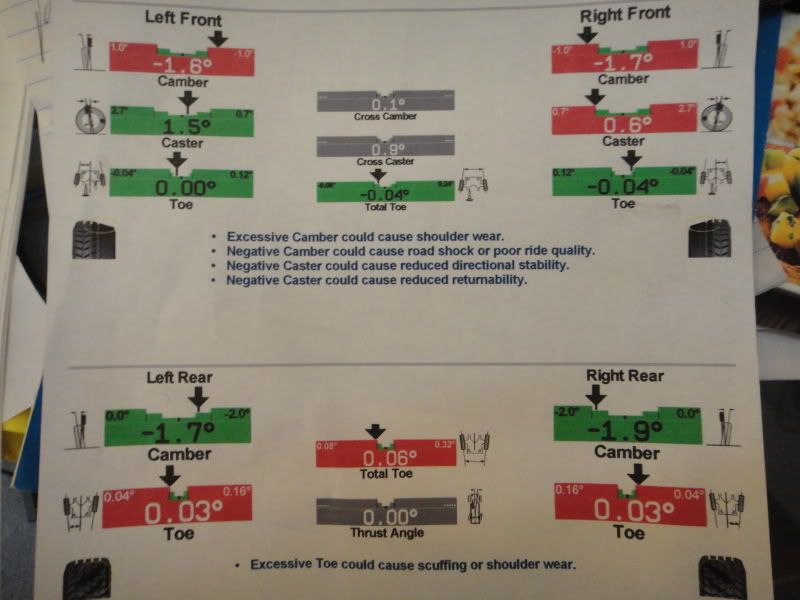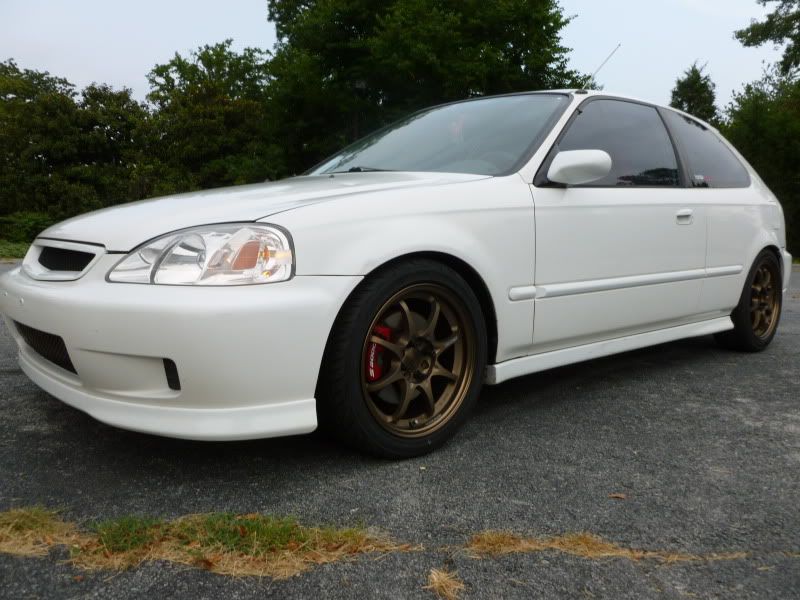"ek" forever guy, I bet if you take your car to another shop and have the alignment checked it will NOT be within factory spec (by a long shot) simply because you cannot adjust for 4° of negative camber on a stock suspension setup. The tech wasn't an idiot, he was telling you the truth. And if you think your tires have even wear while riding with that much negative camber without regularly rotating them inside-to-outside, you're sadly naive and mistaken.
- Home
- Forums
- Honda Civic Gen Tech and Builds / Show Offs
- Wheels / Tires / Brakes / Suspension (All Gens)
Negative Camber
- Thread starter bkjj77
- Start date
But I do regularly rotate my tires, as everyone should. And I haven't had 4* of camber since high school. ~2* is what I've ran on front and rear lately. And factory spec is ~.5* camber anyway. 0* camber is bad.
My point here, is that MOST people with normal drops of 1-3* camber do not need camber kits. With proper toe and caster your tires will wear evenly. Mine have for the last two sets of <300 UAA rating tires tires with these alignment specs:

Picture of the car:

My point here, is that MOST people with normal drops of 1-3* camber do not need camber kits. With proper toe and caster your tires will wear evenly. Mine have for the last two sets of <300 UAA rating tires tires with these alignment specs:

Picture of the car:

Just because that's what my most recent alignment is doesn't mean it was 2* earlier in the autocross season, and 4* in high school. My old civic was very low.There's a big difference between 1.7 and 2-4
This thread makes me laugh...
When I sit in the driver's seat you can't stick your finger between the tire and fender.That hatch is tucking tire??? I think not. It reminds me of a Honda civic f150
The front springs are a little soft (350lbs) so the front left is ~.5" higher than the left. When I'm in the car it's even. With a passenger the right tire scrubs on turns.
Ahhh, I see.When I sit in the driver's seat you can't stick your finger between the tire and fender.
The front springs are a little soft (350lbs) so the front left is ~.5" higher than the left. When I'm in the car it's even. With a passenger the right tire scrubs on turns.
I'm guessing people have forgotten this: http://www.clubcivic.com/board/showthread.php?t=199650
2 March 2010 edit: Just to be clear, I made this thread to disspell the myths perpetuated by magazines and other sources since the mid-1990's that a camber kit is REQUIRED to prevent excessive tire wear after a car is lowered. This is a flat-out LIE! Please read on to see why.
-------------------------------------------
Well I guess this thread is long overdue, as I've had several requests to make a thread like this.
Despite the myths that have been perpetuated since the mid-90's, camber kits ARE NOT required to prevent uneven tire wear after lowering a Honda. Even the very first issue of Super Street magazine in 1996 talks about installed camber kits to prevent tire wear.
Here's what really happens. When you lower your Honda, especially those with double-wishbone suspension, the camber angle goes negative, but the front tires also toe out. That toe-out condition is what is important. Toe-out will destroy the inside edge of a tire MUCH faster than negative camber ever will, because the tire scrubs on the pavement as it rolls in a toe-out condition.
So the myth has been that you need a camber kit to bring the camber angle (non-adjustable on most Hondas) back to stock specs. So you install a kit, take the car to alignment shop, and *poof* no more tire wear. However, what really happened is that along with adjusting the camber, the shop also adjusted the toe. That toe adjustment is what REALLY saved your tires.
The truth of the matter is that you have made your car handle worse with straight-up zero camber (or close to it). It is also truth you can easily run -1.5, -2, -3, even close to -4 camber up front with very little tire wear issues. You just need to be sure to keep your alignment in check and rotate your tires every 5K miles or so. You should get an alignment at least once a year, or better twice a year if possible. All you need to do is get the toe adjusted back to stock specs. If the shop tries to sell you a camber kit, tell them no, just adjust the toe. If they say they can't do the alignment until you get a camber kit, then leave immediately and go to another shop because that is 100% COMPLETELY FALSE!
So let's talk about the "cons" of camber kits:
What are the "pros" of camber kits? Well you can add MORE negative camber than what you get from lowered suspension geometry alone, which can be good for track use. Other than that, I can't really think of anything.
- Cost, plus the extra cost of alignments every time (could be $150 or more)
- Usually made of sub-par materials that rust, corrode, and seize up
- Greatly reduces suspension travel clearance, both UCA replacements and just the bolt-type kits
- Bolt-type kits are nearly impossible to keep straight and adjust correctly without throwing caster off
- UCA-replacement kits often use POS ball joints and have even more reduced clearance under the fender
- Likely to slip out of adjustment, requiring another expensive alignment
One exception: A few relatively newer Honda models, such as the 96-00 Civic, the rear suspension has a pretty steep camber curve, and could benefit from slightly reducing the negative camber in the rear from what you get from a drop alone. I would recommend the replacement rear upper arm-type camber kits. Those use a turnbuckle-type adjustment that will not slip.
And now for some personal experience. I lowered my car back in early 2002 and had about -2* camber up front. I've been on various suspension setups since then with anywhere from -1.5* to -2.8* front camber and have NEVER used a camber kit. Since then I've driven about 175K miles, and I've only been through 5 or 6 sets of tires. I've always used V or W-rated summer tires, and they always last 30K-35K miles.
Now I do get a slight bit of inner wear, but I attribute that to my worn stock bushings that aren't keeping the toe in check like they should. I have all new bushings waiting to go in and I expect tire wear to be even less than before. But my tires do usually wear down past the wear bars before the inner edge shows any belts, so at that time it's time to replace the tires anyway.
I know there are many others on this site who can relate similar personal experiences. I'll let them chime in if they want.
Well that's about all I can think of to say. Hopefully this will help to dispel some of the myths. Hopefully I can help some people keep some extra money instead of wasting it all on camber kits and expensive alignments.
*edit* something else to add - lower profile tires will tend to wear a bit more on the inside edge with negative camber, even with proper alignment. I do get a bit more inner wear on my 205/45-16's than I did on my 195/55-15's or 205/50-15's. I would imagine 40-series tires would be worse. A taller sidewall can flex more, therefore more even pressure is maintained across the tread even with negative camber.


